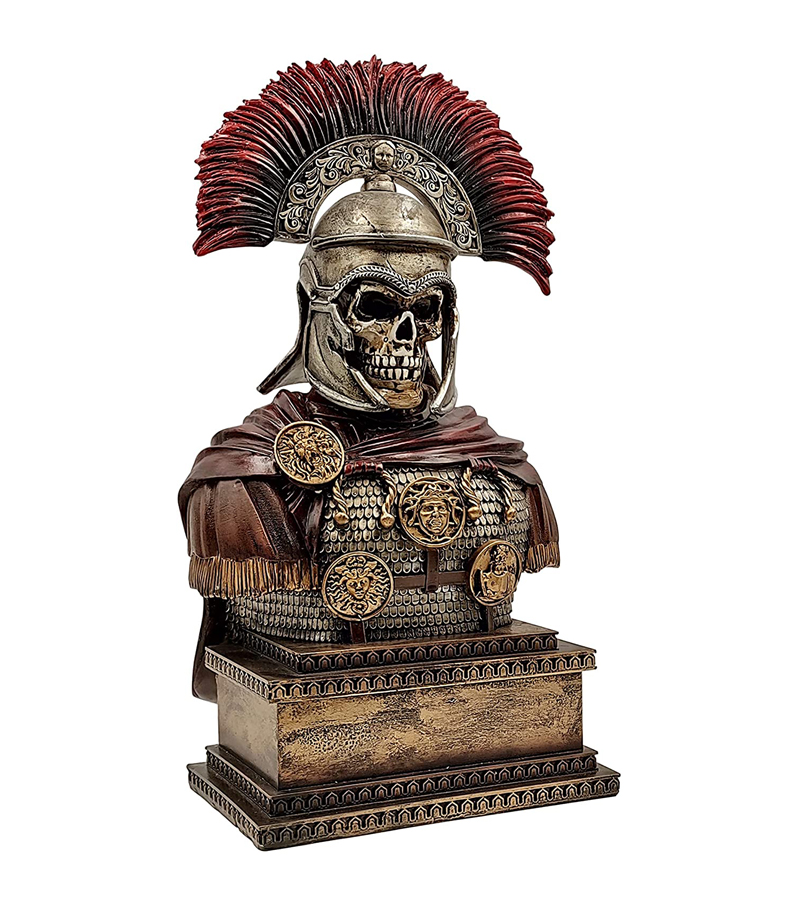Mars Roman God of War Statue
This God Mars Statue is beautifully designed, sculpted and handcrafted to the finest detail in cold cast metal (bronze/pewter) finish. The special production process of this piece, originated from Great Britain, uses actual bronze powder mixed in the cold cast resin in order to ensures a richer and more authentic presentation. Mars is the God of War and the God of Agriculture and Fertility in early Roman history. He is portrayed as a warrior in full battle armor, wearing a crested helmet and bearing a shield. He is known as the God Ares in Greek literature. The animals associated with Mars are Wolves and Woodpeckers. The month March (Martius) is named after him (wars were often started or renewed in spring). In ancient Roman religion and myth, Mars was the God of War and also an Agricultural Guardian, a combination characteristic of early Rome. He was the son of Jupiter and Juno, and he was the most prominent of the military Gods in the religion of the Roman army. Most of his festivals were held in March, the month named for him (Latin Martius), and in October, which began the season for military campaigning and ended the season for farming.
Under the influence of Greek culture, Mars was identified with the Greek God Ares, whose myths were reinterpreted in Roman literature and art under the name of Mars. But the character and dignity of Mars differed in fundamental ways from that of his Greek counterpart, who is often treated with contempt and revulsion in Greek literature. Mars’s altar in the Campus Martius, the area of Rome that took its name from him, was supposed to have been dedicated by Numa, the peace-loving semi-legendary second king of Rome. Although the center of Mars’s worship was originally located outside the sacred boundary of Rome (pomerium), Augustus made the God a renewed focus of Roman religion by establishing the Temple of Mars Ultor in his new forum. Although Ares was viewed primarily as a destructive and destabilizing force, Mars represented military power as a way to secure peace, and was a father of the Roman people. In the mythic genealogy and founding myths of Rome, Mars was the father of Romulus and Remus by his rape of Rhea Silvia.
His love affair with Venus symbolically reconciled the 2 different traditions of Rome’s founding, Venus was the divine mother of the hero Aeneas, celebrated as the Trojan refugee who “founded” Rome several generations before Romulus laid out the city walls. The word Mārs (genitive Mārtis), which in Old Latin and poetic usage also appears as Māvors (Māvortis), is cognate with Oscan Māmers (Māmertos). The oldest recorded Latin form, Mamart-, is likely of foreign origin. It has been explained as deriving from Maris, the name of an Etruscan Child-God, though this is not universally agreed upon. Scholars have varying views on whether the 2 Gods are related, and if so how. Latin adjectives from the name of Mars are Martius and Martialis, from which derive English “Martial” (as in “martial arts” or “martial law“) and personal names such as “Marcus“, “Mark” and “Martin“. Mars may ultimately be a thematic reflex of the Proto-Indo-European God Perkwunos, having originally a thunderer character. Mars Roman God of War Statue sizes: 16 inches / 40.5 cm x 12.5 inches / 32 cm x 6.5 inches / 16.5 cm.
God Mars Statue on Amazon.
God Mars Statue on eBay.
Roman Empire Statues, Military Statues and Gods Statues.







You must be logged in to post a comment.